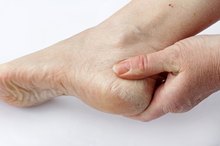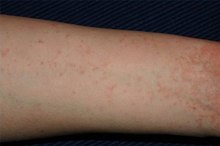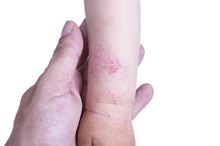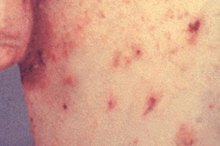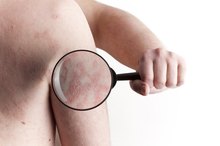What does fact checked mean?
At Healthfully, we strive to deliver objective content that is accurate and up-to-date. Our team periodically reviews articles in order to ensure content quality. The sources cited below consist of evidence from peer-reviewed journals, prominent medical organizations, academic associations, and government data.
The information contained on this site is for informational purposes only, and should not be used as a substitute for the advice of a professional health care provider. Please check with the appropriate physician regarding health questions and concerns. Although we strive to deliver accurate and up-to-date information, no guarantee to that effect is made.
Mites are small parasitic arachnids that prey on insects and feed on plants and animals, including humans. In humans, these microscopic bugs crawl beneath the skin causing scabies, an extremely itchy and contagious skin infection. Scabies mites lay eggs under the skin and feed on skin and secretions 2. They may go unnoticed until the skin becomes irritated and starts to itch.
Symptoms
Scabies mites tend to show up in creases or folds in the skin such as under the breasts, in the groin area, on the wrists, behind the knees and in between the webbing of fingers. Signs of scabies include small blisters, a pimple-like rash and intense itching in the affected area. Mites can live for up to two months on a human host, but only survive two to three days on items such as bedding, clothing and towels. Humans can transmit mites to other humans through prolonged direct skin to skin contact.
- Scabies mites tend to show up in creases or folds in the skin such as under the breasts, in the groin area, on the wrists, behind the knees and in between the webbing of fingers.
- Mites can live for up to two months on a human host, but only survive two to three days on items such as bedding, clothing and towels.
Oatmeal
How to Get Rid of Sarcoptic Mange in People
Learn More
Adding oatmeal to a bath water is a natural way to relieve itching. For best results use cool or lukewarm water, as hot water tends to dry out the skin and may aggravate the itching. After soaking, rinse the skin with cool water and pat dry. Avoid rubbing the skin with the towel, as it can cause further aggravation.
- Adding oatmeal to a bath water is a natural way to relieve itching.
- For best results use cool or lukewarm water, as hot water tends to dry out the skin and may aggravate the itching.
Oils
Certain oils can help relieve irritation and itching from skin mites. Tea tree oil can be diluted in bath water to help relieve itching. It can also be mixed with witch hazel or applied undiluted directly to the affected area with a cotton ball to treat scabies. Lavender essential oil applied to the affected skin area can also provide itching relief. Another effective treatment is neem oil, a natural pesticide that penetrates the skin to relieve pain, itching and irritation caused by scabies mites.
- Certain oils can help relieve irritation and itching from skin mites.
- Lavender essential oil applied to the affected skin area can also provide itching relief.
Washing
Itchy Skin From Parasites
Learn More
Clothes, towels and bedding used by someone infected with skin mites should be machine washed in hot water and dried on the hottest cycle. Furniture and carpets should be cleaned and vacuumed. Items that can’t be washed should not come in contact with the skin for a minimum of 72 hours, which is the life span of mites on surfaces.
Related Articles
References
- Illinois Department of Public Health: Mites Affecting Humans
- Centers for Disease Control and Prevention: Scabies
- Scabies. World Health Organization.. May 20, 2019.
- CDC - Scabies - Disease. Centers for Disease Control and Prevention. Nov 2, 2010.
- Harvard Health Publishing. Scabies. Harvard Health. Dec 2018.
- Mrázová Z, Jadrníčková I, Brabcová K, Spurný F. Fragmentation of Ne ions with energy 400 MeV/u behind targets from different materials measured with PNTD. Radiation Measurements. 2010;45(10):1438-1440. doi:10.1016/j.radmeas.2010.06.048.
- Patel VM, Lambert WC, Schwartz RA. Safety of Topical Medications for Scabies and Lice in Pregnancy. Indian J Dermatol. 2016;61(6):583-587. doi:10.4103/0019-5154.193659
- CDC - Scabies - Resources for Health Professionals - Medications. Centers for Disease Control and Prevention. Oct 2, 2019.
- CDC - Scabies - General Information - Frequently Asked Questions (FAQs). Centers for Disease Control and Prevention. Oct 24, 2018.
- Arlian LG, Morgan MS. A review of Sarcoptes scabiei: past, present and future. Parasit Vectors. 2017 Jun 20;10(1):297. doi: 10.1186/s13071-017-2234-1.
- CDC. Scabies. Resources for Health Professionals, Medications.
- Micali G, Lacarrubba F, Verzì AE, Chosidow O, Schwartz RA. Scabies: Advances in Noninvasive Diagnosis. PLoS Negl Trop Dis. 2016 Jun 16;10(6):e0004691. doi: 10.1371/journal.pntd.0004691. eCollection 2016 Jun.
Writer Bio
Nico Riley has been a professional writer since 2006 with work appearing on various websites. Riley holds an associate degree in criminal justice from Harold Washington College and a Bachelor of Arts in sociology from the University of Illinois at Chicago. She enjoys writing on topics about society, culture, health, self-help and entertainment.

